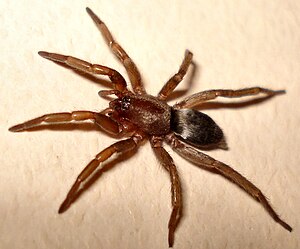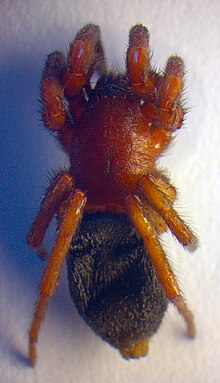Little mouse spider
| Little mouse spider | ||||||||||||
|---|---|---|---|---|---|---|---|---|---|---|---|---|

Small mouse spider ( Scotophaeus blackwalli ), female |
||||||||||||
| Systematics | ||||||||||||
|
||||||||||||
| Scientific name | ||||||||||||
| Scotophaeus blackwalli | ||||||||||||
| ( Thorell , 1871) |
The small mouse spider ( Scotophaeus blackwalli ), often simplified and like the genus also known as mouse spider , is a spider from the family of flat-bellied spiders (Gnaphosidae). The species, which was once only spread across the Palearctic , was also introduced in North America and Peru , where it was able to establish itself.
Applied in the English language common name Mouse spider , which translates also "Mouse Spider" means it shares with the unrelated closer and in Australia popular little red-headed Mouse Spider ( Missulena occatoria ) whose bite can also run in humans with medical consequences. In contrast to this, the little mouse spider is completely harmless to humans.
features

The female of the small mouse spider reaches a body length of seven to 11.7 and the male one of 4.7 to 9.3 millimeters. Like many flat-bellied spiders and all mouse spiders ( Scotophaeus ), this species is also characterized by a low-contrast coloration.
The basic color of the small mouse spider is light to red-brown, although the legs and pedipalps (transformed extremities in the head area) appear darker, as does the carapace (back shield of the prosoma or front body) on the front and the chelicerae (jaw claws).
The femora (thighs) of the third and fourth pair of legs also have three spines each on the dorsal side. In addition to the genital morphological features, this leg thorn is necessary for an exact differentiation of the small mouse spiders from similar species of the genus.
The opisthosoma (abdomen) has dorsally applied hair that is silvery shiny in living individuals. As with the other species of mouse spiders, the appearance of the opisthosoma, which is reminiscent of a mouse, gives the small mouse spider its name, in addition to the mode of locomotion.
Structure of the sexual organs
Every single bulb (male sexual organ) has a tibial apophysis ( chitinized process) which is shorter than the tibia (splint) of this extremity itself. This process is pointed at the front. The otherwise short and straight embolus (insertion organ of the globe) is curved in an S-shape on the distal side.
The epigyne (female sex organ) is flat overall and small compared to the size of the spider. At the front edge there is a small, rearward bulge. The vulva has large, spherically inflated glands arranged medially, which are considerably larger in the small mouse spider than in the other Central European species.
Similar species

The small mouse spider resembles the other species of the mouse spider genus and can usually only be reliably distinguished from the three other species of this genus occurring in Central Europe by genital morphological features and the thorns of the femora of the third and fourth pair of legs.
The spotted mouse spider ( Scotophaeus scutulatus ), which is also widespread in Central Europe and belongs to the same genus, has only two spines instead of three. The position of the spines is the same in both species.
Occurrence
The small mouse spider was originally only distributed in Europe (predominantly northwestern Europe ), Tunisia , parts of the Caucasus and Iran , although it has not been detected in many parts of northeastern Europe. The same applies to Novaya Zemlya , Iceland , Finland , Northern Ireland , the Czech Republic , the Republic of Moldova , Slovenia , Bosnia and Herzegovina , all of Turkey , Armenia and Azerbaijan . In Germany the species is only common in the north and west.
In North America , the small mouse spider was introduced to the United States , where it has so far been found in the western US states of California , Colorado , Oregon , Washington, and Hawaii . With finds of the species from Peru it has meanwhile also been proven in South America .
Habitats

The small mouse spider can be found in the wild under the bark of trees and in tree stumps. The occurrence of the species in gardens and in bush landscapes has also been documented.
In addition, the little mouse spider shows a pronounced synanthropy (favors human settlement areas), particularly in the northern parts of its range, including in northern Great Britain and especially in the United States , so that it can also be found inside buildings there. In urban regions, it can also be found on wooden fences and under the bark of dead trees.
The small mouse spider can be found up to a height of 400 meters above sea level.
Threat and protection
The general frequency of the small mouse spider varies depending on the geographical location. However, there are probably no acute threats to the population of the species.
In the United Kingdom, for example, the lesser mouse spider is particularly common in England and Wales and particularly in the counties of Leicestershire and Rutland , but is less common in Scotland . To the north, the main distribution area ends in the county of Kincardineshire . The IUCN lists the species in the UK in the LC (least concern) category. It is therefore not subject to any protection status there.
In Germany, on the other hand, the small mouse spider, which is only found in the north and west of the country, is much rarer. In the Red List of Endangered Species of Animals, Plants and Mushrooms in Germany , the little mouse spider is classified as "not endangered ", which means that it does not enjoy any legal protection here either.
The general population of the small mouse spider is not rated by the IUCN.
Way of life
Like most species of flat-bellied spiders, the little mouse spider is nocturnal and shares with the other members of this family its rapid locomotion, from which it occasionally comes to a sudden stop. In this way of movement, the spider, together with the optical appearance of its opisthosoma, is reminiscent of a mouse, which, as with the other species of the genus, has led to the term "mouse spider".
The species spends the day like other nocturnal flat-bellied spiders in a web of living space .
Hunting behavior and catch of prey
The little mouse spider, like almost all spiders , lives predatory , but like the other flat-bellied spiders does not create a spider web to catch prey, but hunts freely as a hunter . The hunting behavior as such does not differ from that of other representatives of the family, which means that this species either incapacitates its prey with the help of a direct jump attack and a poison bite that occurs during this time or, if the prey is defensive, first immobilizes it with spider silk (see section " Hunting modes "in the article flat-bellied spiders).
The small mouse spider prefers to prey on smaller insects , but is also known to accept dead individuals as food.
Life cycle
Like many spider species common in temperate climates, the little mouse spider also has a life cycle that is divided over the seasons and divided into several sections.
Phenology
The activity time of adult individuals extends for both sexes of the small mouse spider to the whole year. However, they are most active from summer to autumn.
Reproduction
As with many other flat-bellied spiders, the mating behavior of the small mouse spider has not been researched. A mated female creates a brood chamber made of spider silk around her, on the wall of which she creates a disc-shaped egg cocoon with a diameter of 10 to 12 millimeters, which is typical for the family and contains around 50 to 130 eggs. The top of the cocoon is closed with a thick layer of spider silk. As is customary with flat-bellied spiders, the female herself guards her egg cocoon until the young hatch.
Systematics
When it was first described in 1871 by the author Tord Tamerlan Teodor Thorell, the little mouse spider, like all flat-bellied spiders back then, was classified in the now defunct genus Drassus and given the name Drassus blackwallii . By Władysław Kulczyński it was first in the genre of the mouse spiders ( Scotophaeus ) under their applicable today designation Scotophaeus black walli incorporated, since a 1977 carried out revision of the genus mouse spiders by Norman Ira Platnick and Mohammad Umar Shadab is applied consistently. The British naturalist John Blackwall is to be honored with the species name blackwalli .
The little mouse spider has three subspecies:
- S. blackwalli isabellinus ( Simon , 1873) , distributed on Corsica, Italy and Croatia
- S. blakwalli politus ( Simon , 1878) , occurring in parts of France
- S. blackwalli blackwalli ( Thorell , 1871) , nominate form, in all other parts of the range
gallery
Individual evidence
- ↑ a b c d e Scotophaeus blackwalli (Thorell, 1871) from Spider ID, accessed June 23, 2020.
- ↑ a b c d e f g h Scotophaeus blackwalli (Thorell, 1871) from araneae - Spiders of Europe, accessed on June 23, 2020.
- ↑ a b c d e f g h i Scotophaeus blackwalli (Thorell, 1871) at the Wiki der Arachnologische Gesellschaft e. V., accessed on June 23, 2020.
- ↑ a b c d e f g h i j Scotophaeus blackwalli (Thorell, 1871) at NatureSpot, accessed on June 23, 2020.
- ↑ a b c d e f g h Scotophaeus blackwalli (Thorell, 1871) at the British Arachnological Society, accessed June 23, 2020.
- ↑ Scotophaeus blackwalli (Thorell, 1871) at BugGuide.net, accessed June 23, 2020.
- ↑ Scotophaeus blackwalli (Thorell, 1871) at the Red List Center, accessed on June 23, 2020.
- ↑ Scotophaeus blackwalli (Thorell, 1871) at Global Biodiversity Information Facility , accessed June 23, 2020.
- ↑ Scotophaeus blackwalli (Thorell, 1871) in the WSC World Spider Catalog , accessed June 23, 2020.
- ↑ Scotophaeus blackwalli (Thorell, 1871) from Fauna Europaea , accessed June 23, 2020.
literature
- Heiko Bellmann: The cosmos spider guide. Over 400 species in Europe. Kosmos Naturführer, Kosmos (Franckh-Kosmos), 2nd edition, 2016, ISBN 978-3-440-14895-2 .
Web links
- Scotophaeus blackwalli in the World Spider Catalog
- Scotophaeus blackwalli (Thorell, 1871) at the Global Biodiversity Information Facility
- Scotophaeus blackwalli (Thorell, 1871) in Fauna Europaea
- Scotophaeus blackwalli (Thorell, 1871) at the Red List Center
- Scotophaeus blackwalli (Thorell, 1871) in araneae - Spiders of Europe
- Scotophaeus blackwalli (Thorell, 1871) at the Wiki of the Arachnological Society e. V.
- Scotophaeus blackwalli (Thorell, 1871) at the British Arachnological Society
- Scotophaeus blackwalli (Thorell, 1871) at BugGuide.net
- Scotophaeus blackwalli (Thorell, 1871) on Spider ID
- Scotophaeus blackwalli (Thorell, 1871) at NatureSpot










